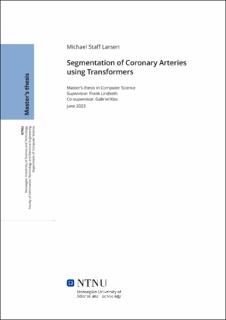| dc.contributor.advisor | Lindseth, Frank | |
| dc.contributor.advisor | Kiss, Gabriel | |
| dc.contributor.advisor | Fossan, Fredrik Eikeland | |
| dc.contributor.author | Larsen, Michael Staff | |
| dc.date.accessioned | 2023-08-18T17:19:33Z | |
| dc.date.available | 2023-08-18T17:19:33Z | |
| dc.date.issued | 2023 | |
| dc.identifier | no.ntnu:inspera:145904930:46815042 | |
| dc.identifier.uri | https://hdl.handle.net/11250/3084898 | |
| dc.description.abstract | Koronar hjertesykdom (CAD) er en betydelig helseutfordring på verdensbasis. Tilstanden diagnostiseres tradisjonelt med invasive, kostbare metoder som Invasive Coronary Angiography (ICA) og invasive Fractional Flow Reserve (FFR)- målinger. Disse prosedyrene medfører imidlertid assosierte risikoer. Som et resultat har det vært en overgang mot å bruke den tryggere, mer kostnadseffektive Coronary Computed Tomography Angiography (CCTA), en ikke-invasiv avbildningsteknikk. De siste årene har det vært økende forskningsinteresse for å øke CCTA’s diagnostiske potensial gjennom automatisk segmentering av koronararteriene.
Denne masteroppgaven fokuserte på å evaluere ytelsen til Shifted Window U- Net Transformer (SWIN UNETR), en transformer-basert arkitektur, sammenlignet med nåværende Convolutional Neural Network (CNN)-baserte metoder som no new U-Net (nnU-Net) for segmentering av koronararterier. Våre eksperimenter avdekket at SWIN UNETR-modellen overgikk tidligere resultater med en Dice Score (DSC) på 0.8614 mot 0.8296 på ImageCAS datasettet. Videre sikret SWIN UNETR 7. plass i ASOCA Challenge med en konkurransedyktig DSC på 0.8663. Når den ble sammenlignet med nnU-Net på St. Olavs Hospital datasettet, demonstrerte SWIN UNETR overlegen ytelse i form av DSC og med færre store artefakter i sine prediksjoner.
Videre ble integrasjonen av automatisk segmentering av koronararterier med tid- ligere FFR estimeringsarbeid undersøkt. Selv om noen områder trengte manuelle korreksjoner, ble SWIN UNETR-modellen vellykket brukt som input til FFR-estimeringsmetoden og ga en sterk korrelasjon med fysisk målte FFR-verdier. Dens anvendelse i klassifisering av stenose som funksjonelt betydelig (FFR < 0.8), viste en lovende følsomhet på 85,7% sammenlignet med fysiske målinger. Dette resultatet overgikk følsomheten ved bruk av klinisk segmenterte arterier som input.
Oppsummert ble det funnet at SWIN UNETR utmerket seg til segmentering av koronararterier fra CCTA-bilder sammenlignet med nåværende CNN-metoder. I tillegg ga kombinasjonen av automatisk segmentering og FFR-estimering lovende resultater når den ble kombinert med noen mindre manuelle korreksjoner. Både segmenteringen og kombinasjonen med FFR-estimering kan derfor være verdifulle verktøy for klinisk vurdering av CAD fra CCTA bilder. | |
| dc.description.abstract | Coronary Artery Disease (CAD) is a significant health issue worldwide. The condition is traditionally diagnosed with invasive, costly methods such as Invasive Coronary Angiography (ICA) and invasive Fractional Flow Reserve (FFR) measurements. These procedures, however, carry associated risks. As a result, there’s been a shift towards using the safer, more cost-effective Coronary Computed Tomography Angiography (CCTA), a non-invasive imaging technique. Recent years have seen growing research interest in boosting CCTA’s diagnostic potential via auto-mated coronary artery segmentation.
This thesis focused on evaluating the performance of Shifted Window U-Net Trans- former (SWIN UNETR), a transformer-based architecture, and contrasting it with current Convolutional Neural Network (CNN)-based methods like no new U-Net (nnU-Net) for coronary artery segmentation. Our experiments revealed that the SWIN UNETR model surpassed previous benchmarks with a Dice Score (DSC) of 0.8614 versus the earlier 0.8296 on the ImageCAS dataset. Moreover, it secured 7th place in the ASOCA Challenge with a competitive DSC of 0.8663. When compared to nnU-Net on the St. Olavs Hospital dataset, SWIN UNETR demonstrated superior performance in terms of DSC and with fewer large artifacts in its predictions.
Furthermore, the integration of automatic coronary artery segmentation with prior FFR estimation work was examined. Although a few areas needed manual corrections, the SWIN UNETR model was successfully used as the input to the FFR estimation method and yielded a strong correlation with physically measured FFR values. Its application in classifying stenosis as functionally significant (FFR < 0.8), demonstrated a promising sensitivity of 85.7% compared to physical measurements. This result exceeded the sensitivity of using clinically segmented arteries as input.
In summary, SWIN UNETR was found to excel at the task of coronary artery segmentation from CCTA images compared to current CNN methods. Additionally, the combination of automatic segmentation and FFR estimation gave promising results when combined with some minor manual corrections. Both the segmentation and combination with FFR estimation could therefore be valuable tools for clinical assessment of CAD from CCTA. | |
| dc.language | eng | |
| dc.publisher | NTNU | |
| dc.title | Segmentation of Coronary Arteries using Transformers | |
| dc.type | Master thesis | |
